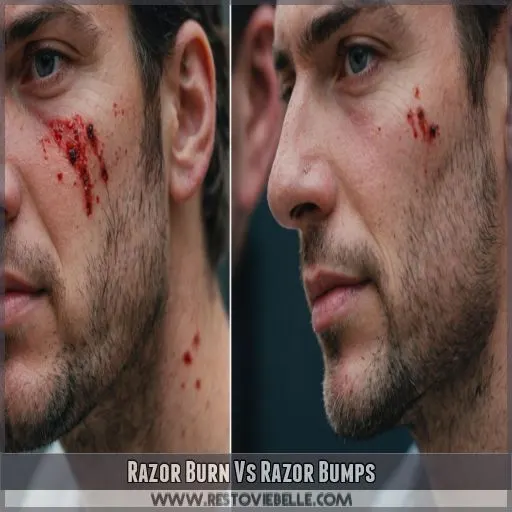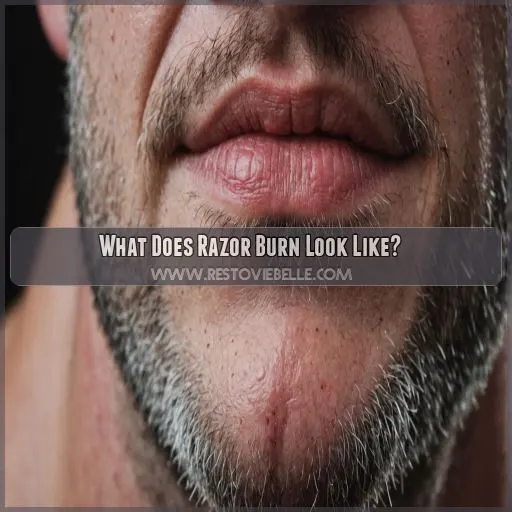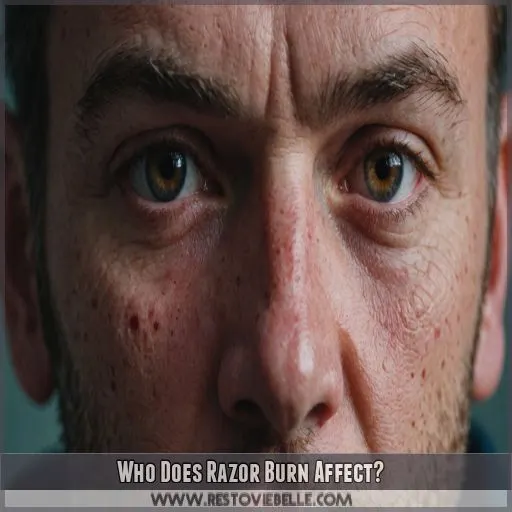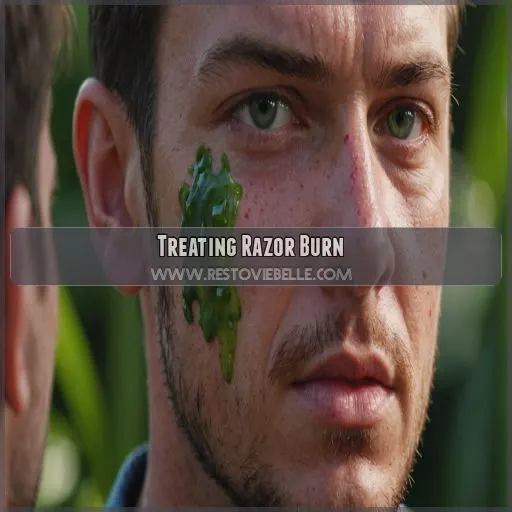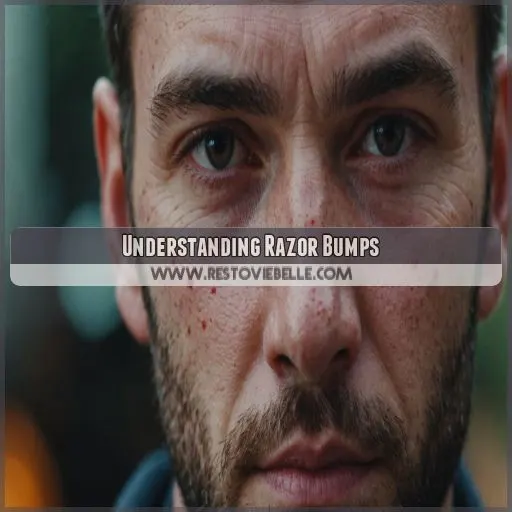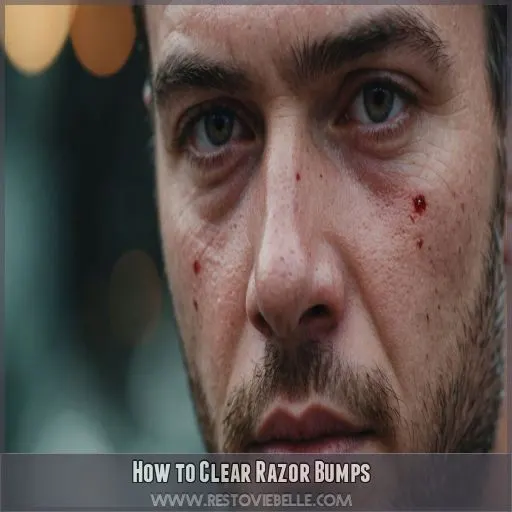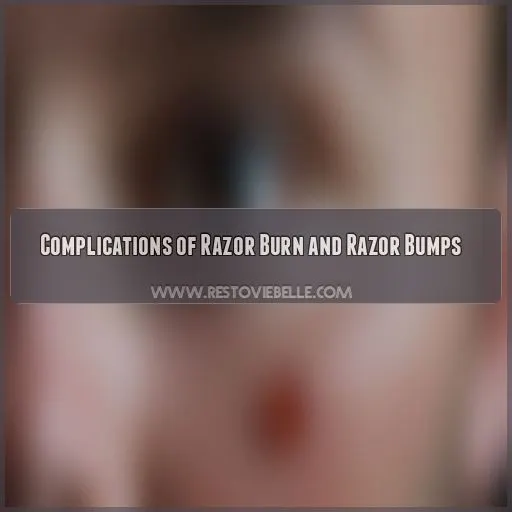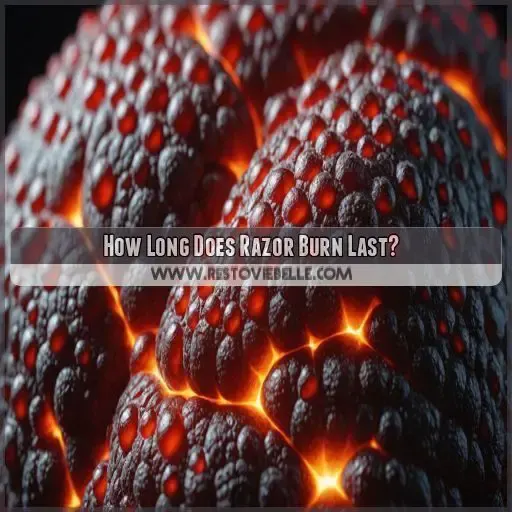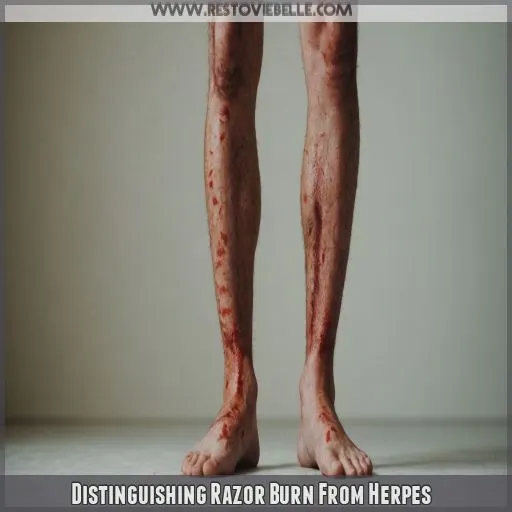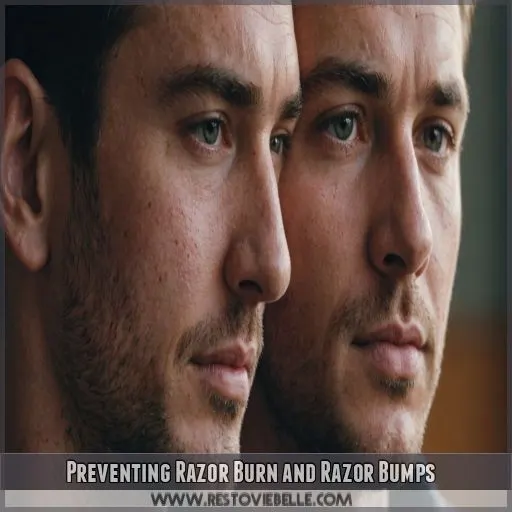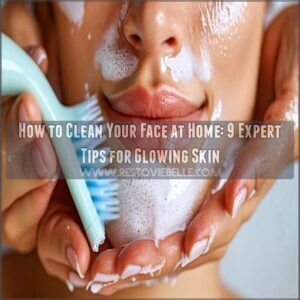This site is supported by our readers. We may earn a commission, at no cost to you, if you purchase through links.
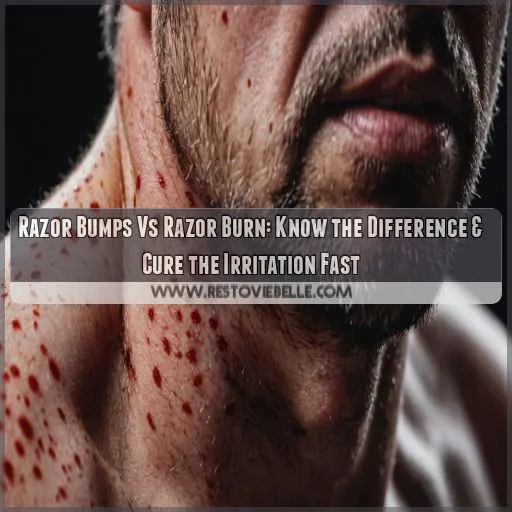 The age-old battle of razor bumps vs razor burn. You know, that pesky redness and irritation that shows up after shaving.
The age-old battle of razor bumps vs razor burn. You know, that pesky redness and irritation that shows up after shaving.
Razor burn is a skin irritation caused by shaving, usually resulting in red, itchy patches. Razor bumps, on the other hand, are ingrown hairs that grow back into the skin, causing inflammation and bumps.
Think of it like a party crasher (razor burn) vs an uninvited guest who won’t leave (razor bumps).
To keep these unwanted guests at bay, you’ll want to master the art of shaving and after-care – stay tuned for the secrets to smooth, bump-free skin.
Table Of Contents
- Key Takeaways
- Razor Burn Vs Razor Bumps
- What Does Razor Burn Look Like?
- Who Does Razor Burn Affect?
- Treating Razor Burn
- Understanding Razor Bumps
- How to Clear Razor Bumps
- Complications of Razor Burn and Razor Bumps
- How Long Does Razor Burn Last?
- Distinguishing Razor Burn From Herpes
- Preventing Razor Burn and Razor Bumps
- Frequently Asked Questions (FAQs)
- Do I have razor burn or bumps?
- What does a razor burn look like?
- How to clear razor bumps?
- How long does it take for razor bumps to go away?
- Can razor burn cause long-term damage to the skin?
- How often should I exfoliate to prevent razor bumps?
- Can razor bumps be a sign of an underlying skin condition?
- Are there any home remedies to reduce razor burn inflammation?
- Can razor burn increase the risk of skin infections?
- Conclusion
Key Takeaways
- You’re not alone in the struggle – razor burn and razor bumps can happen to anyone, regardless of age, gender, or skin type, so don’t be too hard on yourself when they appear.
- Razor burn is like a party crasher – it shows up uninvited and makes a mess, but it’s usually a temporary issue that can be soothed with home remedies like aloe vera or hydrocortisone cream, and it typically clears up on its own within a day or two.
- To prevent razor bumps, you’ll want to become familiar with salicylic acid – it helps exfoliate your skin and prevent ingrown hairs, so try using a cleanser or spot treatment containing salicylic acid to keep those pesky bumps at bay.
- By mastering the art of shaving and after-care, you can say goodbye to razor burn and razor bumps for good – so take the time to learn how to shave with the grain, exfoliate regularly, and moisturize thoroughly to keep your skin happy and healthy.
Razor Burn Vs Razor Bumps
In the matter of shaving, you’ve probably experienced some form of irritation, but do you know whether it’s razor burn or razor bumps? Understanding the difference between these two common issues can help you cure the irritation fast and get back to smooth, healthy-looking skin.
Key Differences and Similarities
Dealing with razor burn and razor bumps can be a real challenge. While both are pesky skin reactions, they’re not identical twins. Razor burn is more about skin irritation, whereas razor bumps are ingrown hairs that can lead to pseudoFolliculitis Barbae. Understanding the difference is key to finding the right cure.
Causes of Razor Burn and Razor Bumps
Regarding razor burn and razor bumps, shaving techniques and razor types play a significant role. Skin preparation, hair texture, and friction irritation can also cause these pesky issues. Dry shaving, shaving too fast, or using a dull blade can lead to razor burn, while curly or coarse hair can cause razor bumps.
Identifying Symptoms of Each Condition
Regarding razor burn and razor bumps, symptom overlap can be confusing. To identify each condition, look for these distinct signs:
- Redness Indicators: Razor burn often appears as patches of redness, while razor bumps are characterized by skin discoloration and bump formation.
- Itching Patterns: Razor burn typically causes a burning sensation and general irritation, while razor bumps are often accompanied by intense itching.
- Skin Texture: Razor bumps can feel like sandpaper, while razor burn may feel smooth to the touch but still painful.
What Does Razor Burn Look Like?
You’ve probably experienced the pesky redness and itchiness of razor burn at some point.
Razor burn typically shows up as red, irritated patches on your skin, often with a streaky appearance.
It can pop up anywhere you shave, from your face and neck to your legs and pubic area.
Physical Characteristics of Razor Burn
Razor burn’s physical characteristics – it’s not pretty! Imagine red, irritated skin with visible bumps, and you’re in the right ballpark. Here’s a breakdown:
| Razor Burn Symptoms | Skin Texture Changes | Burn Severity Levels |
|---|---|---|
| Redness and Irritation | Dry, itchy skin | Mild: Pinkish hue |
| Swelling and Bumps | Flaky, scaly skin | Moderate: Red, inflamed |
| Stinging Sensation | Tender to the touch | Severe: Blisters, bleeding |
| Visual Indicators | Irritated skin, ingrown hairs | Extremely painful |
Your skin’s crying for help!
Common Areas Affected by Razor Burn
Razor burn can strike anywhere you shave! Common areas include legs and thighs, underarms, pubic area, face, neck, and jawline. If you’re prone to razor burn, you know how frustrating it can be.
- Legs and thighs: Ingrown hairs and razor burn can make walking a painful chore
- Underarm irritation: Redness and bumps can make you feel like ditching your favorite tank tops
- Pubic area care: Razor burn in this sensitive spot can be especially painful and embarrassing
Differences in Appearance From Razor Bumps
You’re probably wondering how to tell razor burn and razor bumps apart. Razor burn often looks like red, irritated skin with a smooth texture, while razor bumps are characterized by small, raised bumps, often with ingrown hairs. Keloid scarring can also occur with razor bumps, especially in darker skin tones.
Who Does Razor Burn Affect?
You’re probably wondering who’s most likely to get razor burn – the answer is anyone who shaves, regardless of age, gender, or skin type! Razor burn can affect people with sensitive skin, those who shave frequently, and even individuals with curly or coarse hair, making it a common issue for many of us .
Demographics and Statistics on Razor Burn
Razor burn can affect anyone who shaves, regardless of gender, age, or race. However, some demographics are more prone to razor burn due to their shaving habits or skin type. Here are some statistics:
- 4 key demographics that are more likely to experience razor burn:
- Young adults: Those who shave frequently, especially during puberty, are more likely to experience razor burn.
- Women: Women who shave their legs, underarms, and bikini areas are more prone to razor burn due to the sensitive skin in these areas.
- African Americans: Those with curly or coarse hair are more likely to experience razor burn due to the hair growing back into the skin.
- Sensitive skin types: People with sensitive skin are more likely to experience razor burn due to their skin’s natural reaction to irritation.
Contributing Factors to Razor Burn
If you’re dealing with razor burn, you might be wondering what’s causing the irritation.
Let’s get to the bottom of it! Several factors contribute to razor burn, including your skin sensitivity, hair type, shaving technique, and blade sharpness.
Using the wrong razor or an old one can also lead to razor burn.
Even some shaving products can irritate your skin.
Switching to a moisturizing shaving cream and changing your razor frequently can make a big difference.
Treating Razor Burn
You’ve fallen victim to razor burn – don’t worry, it’s an easy fix! To treat razor burn, you can try some simple home remedies, over-the-counter treatments, or even prescription creams to soothe that irritated skin and get you back to smooth sailing in no time.
Home Remedies for Soothing Razor Burn
To soothe razor burn, try these home remedies: apply a cool compress, aloe vera, or oatmeal paste to calm the skin. Coconut oil, baking soda, and tea tree oil can also provide relief. For more severe cases, use a hydrocortisone cream. Witch hazel can also help reduce inflammation and itching.
Over-the-Counter Treatments for Razor Burn
Now that we’ve explored home remedies, let’s talk over-the-counter (OTC) treatments for razor burn. You can try topical creams or soothing gels containing aloe vera or hydrocortisone to reduce inflammation. Aftershave balms with cooling ingredients can also help. Look for noncomedogenic products with alpha hydroxy acid to gently exfoliate and soothe the skin.
When to Seek Medical Attention for Razor Burn
If your razor burn persists, worsens, or shows signs of infection, seek medical attention. The American Academy of Dermatology advises consulting a doctor if you experience severe skin reactions, persistent redness, or fluid-filled sores, which can be a sign of herpes simplex viruses. Don’t hesitate – your skin will thank you!
Understanding Razor Bumps
You’re probably no stranger to the pesky red bumps and itchy skin that can show up after shaving, but did you know that razor burn and razor bumps are actually two different issues? Understanding the difference between these two skin irritations is key to treating and preventing them, so let’s get to know razor bumps a little better.
Definition and Causes of Razor Bumps
You’re probably all too familiar with razor bumps, those pesky ingrown hairs that pop up after shaving. But what causes them? Well, it’s often a combo of curly hair, poor shaving techniques, and hair follicle issues. When you shave, the cut hair can curl back into your skin, triggering inflammation and irritation.
Physical Characteristics of Razor Bumps
Here’s the lowdown on the physical characteristics of razor bumps: they can vary in size, cause skin tone changes, and have irregular shapes. Ingrown hairs may be visible, and the surrounding skin can become inflamed, changing color and texture. Bumps may be more noticeable on oily skin or after using a physical scrub.
Differences in Appearance From Razor Burn
Here’s the difference in appearance between razor bumps and razor burn. Razor bumps are usually smaller, more localized bumps, often with a single trapped hair. Razor burn, on the other hand, appears as larger, red, irritated patches, often with a burning sensation. Keep an eye out for distinct redness patterns to tell them apart.
How to Clear Razor Bumps
You’ve got razor bumps, and now you’re wondering how to clear them up – don’t worry, it’s easier than you think. To start, you’ll want to focus on exfoliating and removing dead skin cells, using salicylic acid to prevent re-entry, and mastering gentle hair removal techniques to prevent those pesky bumps from coming back.
Exfoliating and Removing Dead Skin Cells
Exfoliating is key to removing dead skin cells and clearing razor bumps. Try a gentle mechanical scrub or a chemical exfoliant containing alpha-hydroxy acids. You can also use apple cider vinegar as a natural astringent to help balance your skin’s pH. Regular exfoliation promotes skin cell turnover and renewal.
Using Salicylic Acid to Prevent Re-Entry
To prevent ingrown hairs, try using salicylic acid! It helps exfoliate your skin and prevent re-entry. Here’s how:
- Use a cleanser containing salicylic acid to clear pores and remove dead skin cells.
- Exfoliate with a gentle scrub or a chemical exfoliant containing salicylic acid 2-3 times a week.
- Apply a spot treatment with salicylic acid to individual bumps to reduce inflammation.
Gentle Hair Removal Techniques to Prevent Razor Bumps
Now that you’re using salicylic acid to prevent re-entry, it’s time to switch up your hair removal game! Consider gentle alternatives like sugaring, waxing, or depilatory creams. These methods might take some getting used to, but they’ll help reduce razor bumps and leave your skin feeling smoother for longer.
Complications of Razor Burn and Razor Bumps
As you explore shaving, being aware of the potential complications that can arise from razor burn and razor bumps is vital. If left untreated or managed poorly, these issues can lead to infections, scarring, hyper-pigmentation, and even acne-like bumps – not exactly the smooth, glowing skin you’re aiming for!
Infections and Folliculitis Barbae
When you least expect it, razor burn and razor bumps can lead to infections like folliculitis barbae. Don’t panic! You can treat them. Here are some things to keep in mind:
- Shaving over razor bumps can push bacteria into the skin, causing infections.
- Ingrown hairs can become infected with bacteria like Staphylococcus aureus.
- Folliculitis barbae can cause inflammation, redness, and pus-filled bumps.
Scarring and Hyper-Pigmentation
When dealing with razor burn and bumps, you’re likely worried about scarring and hyper-pigmentation. Dark skin is more prone to these issues, but don’t fret! Try hyper-pigmentation treatments, scar fading techniques, and skin toning tips to even out your skin. Prevent keloid formation by keeping the area moisturized and avoiding picking at scabs.
Acne-Like Bumps and Redness
- Ingrown hairs causing folliculitis
- Irritation from razor burn or razor bumps
- Clogged pores and dead skin cells
- Post-shave care gone wrong
- Skin irritation from harsh products
How Long Does Razor Burn Last?
When you’re dealing with razor burn, you’re probably wondering how long it’ll take for the redness and irritation to fade away. The good news is that razor burn usually clears up on its own within a day or two, but with some simple treatments and prevention methods, you can speed up the recovery process and avoid future occurrences.
Factors Affecting Recovery Time
Your razor burn‘s recovery time depends on several factors, including your skin type, shaving frequency, and treatment methods. Good hygiene practices and overall health also play a role. Typically, razor burn lasts a few days to a week. Be patient, and don’t be too hard on your skin – it’s doing its best to heal!
Treatment Options for Speeding Up Recovery
To speed up recovery from razor burn, try home remedies like a cold compress or natural ingredients like aloe vera. Over-the-counter options like hydrocortisone cream can also help. Be patient, as healing time varies. With a little TLC, you’ll be back to smooth skin in no time – usually within a day or two!
Prevention Methods to Avoid Future Occurrences
To avoid future razor burn occurrences, you should revamp your shaving routine. Here are some prevention methods:
- Use gentle shaving techniques and shave in the direction of hair growth
- Exfoliate regularly to remove dead skin cells
- Choose a razor that suits your skin type
- Develop a consistent skin care routine
Distinguishing Razor Burn From Herpes
When you’re trying to soothe a red, itchy rash after shaving, the last thing you want to worry about is whether it’s razor burn or something more serious – like herpes. Let’s break down the key differences between razor burn and herpes, so you can identify what’s going on and get the right treatment.
Visual Differences Between Conditions
When trying to distinguish razor burn from herpes, pay attention to the redness, texture, location, size, and shape of the affected area. Razor burn tends to appear as red, irritated patches with a rough texture, usually in areas you’ve recently shaved. Herpes, on the other hand, typically forms fluid-filled sores in clusters.
Symptoms and Characteristics of Herpes
Distinguishing razor burn from herpes requires knowledge of herpes symptoms and characteristics. Here are some key things to be aware of:
- Herpes skin lesions or blisters that ooze fluid and crust over
- Common herpes symptoms like itching, burning, or tingling sensations
- Oral herpes signs like cold sores or fever blisters on the mouth or lips
When to Seek Medical Attention for Suspected Herpes
If you suspect herpes, don’t hesitate – seek medical attention ASAP! Look for warning signs like fluid-filled sores, itching, or burning sensations. Don’t confuse it with a razor burn rash. Delaying treatment can lead to complications. Consult a doctor, and get tested to determine the best course of action.
Preventing Razor Burn and Razor Bumps
You’re probably no stranger to the pesky red bumps and itchy skin that can come with shaving.
The good news is that preventing razor burn and razor bumps is easier than you think.
Pre-Shave Preparation and Techniques
Before you shave, get your skin ready! Exfoliate gently to remove dead skin cells, and use a pre-shave oil to help the razor glide smoothly. Apply a warm compress to soften hairs, and choose the right razor for your skin type. Shave at a shallow angle to avoid razor burn and bumps.
Post-Shave Care and Moisturizing
After shaving, treat your skin to some TLC! Apply soothing products like aloe vera or gentle moisturizers to calm any irritation. Keep your skin hydrated and consider using shaving creams with built-in moisturizers for extra protection. Don’t forget to clean and lubricate your razor to prevent future razor burn and bumps.
Long-Term Prevention Strategies and Tips
To keep razor burn and bumps at bay, optimize your shaving technique by shaving with the grain and using light strokes. Regularly clean and replace your razor, and exfoliate your skin once a week. Choose a gentle moisturizer and apply it after shaving to keep your skin hydrated and soothed.
Frequently Asked Questions (FAQs)
Do I have razor burn or bumps?
Don’t worry, figuring out what’s going on with your skin can be frustrating! Take a closer look: if you see red, irritated patches, it’s likely razor burn, but if you notice ingrown hairs, it’s probably razor bumps.
What does a razor burn look like?
You’ll know you have razor burn when you spot red, irritated patches on your skin, often with a streaky appearance. It might itch, sting, or feel tender to the touch, and swelling can develop over time.
How to clear razor bumps?
How long does it take for razor bumps to go away?
Razor bumps can be a real nuisance! Luckily, they usually clear up on their own within 2-3 months if you stop shaving and let the hair grow out. With gentle care and patience, you’ll be bump-free in no time!
Can razor burn cause long-term damage to the skin?
Don’t worry, razor burn is usually a temporary issue, but if you’re not careful, it can lead to long-term damage like dark spots, ingrown hairs, or even infection – so, take steps to soothe and prevent it .
How often should I exfoliate to prevent razor bumps?
Exfoliate like your life depends on it – but not too much! Aim for 1-2 times a week to gently remove dead skin cells and prevent razor bumps. Over-exfoliating can lead to irritation, so find your sweet spot!
Can razor bumps be a sign of an underlying skin condition?
You might wonder if razor bumps are a sign of an underlying skin condition – typically, they’re just a reaction to shaving, but in some cases, they can be a symptom of conditions like folliculitis or Keratosis Pilaris.
Are there any home remedies to reduce razor burn inflammation?
Hey, got razor burn? Don’t worry, you can soothe the inflammation with home remedies like aloe vera, cool compresses, or oatmeal baths . Apply a fragrance-free moisturizer and avoid tight clothes to help your skin heal.
Can razor burn increase the risk of skin infections?
Ironically, your quest for smooth skin can sometimes backfire. Razor burn can indeed increase the risk of skin infections, especially if you scratch the affected area or don’t keep it clean and moisturized.
Conclusion
Shaving just got a whole lot smoother.
You’ve mastered the differences between razor burn and razor bumps.
Now it’s time to put your newfound knowledge to the test.
By understanding what causes these pesky problems and how to prevent them, you’ll be saying goodbye to redness and hello to silky skin in no time.

